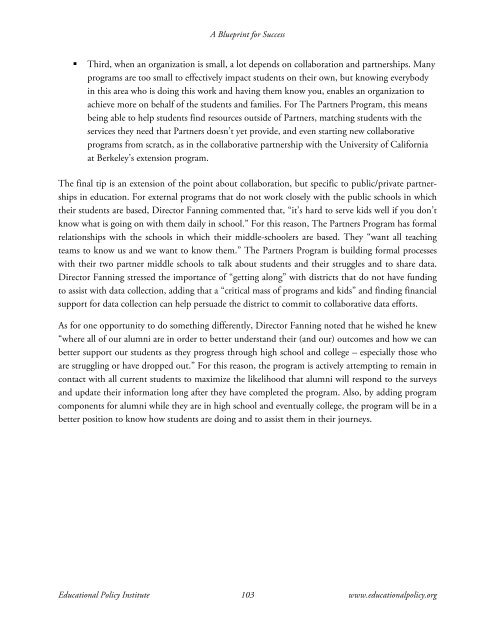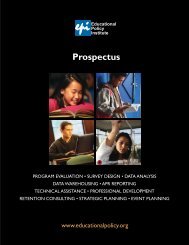A BluePrint for Success: Case Studies of Successful - Educational ...
A BluePrint for Success: Case Studies of Successful - Educational ...
A BluePrint for Success: Case Studies of Successful - Educational ...
You also want an ePaper? Increase the reach of your titles
YUMPU automatically turns print PDFs into web optimized ePapers that Google loves.
A Blueprint <strong>for</strong> <strong>Success</strong><br />
Third, when an organization is small, a lot depends on collaboration and partnerships. Many<br />
programs are too small to effectively impact students on their own, but knowing everybody<br />
in this area who is doing this work and having them know you, enables an organization to<br />
achieve more on behalf <strong>of</strong> the students and families. For The Partners Program, this means<br />
being able to help students find resources outside <strong>of</strong> Partners, matching students with the<br />
services they need that Partners doesn’t yet provide, and even starting new collaborative<br />
programs from scratch, as in the collaborative partnership with the University <strong>of</strong> Cali<strong>for</strong>nia<br />
at Berkeley’s extension program.<br />
The final tip is an extension <strong>of</strong> the point about collaboration, but specific to public/private partnerships<br />
in education. For external programs that do not work closely with the public schools in which<br />
their students are based, Director Fanning commented that, “it’s hard to serve kids well if you don’t<br />
know what is going on with them daily in school.” For this reason, The Partners Program has <strong>for</strong>mal<br />
relationships with the schools in which their middle-schoolers are based. They “want all teaching<br />
teams to know us and we want to know them.” The Partners Program is building <strong>for</strong>mal processes<br />
with their two partner middle schools to talk about students and their struggles and to share data.<br />
Director Fanning stressed the importance <strong>of</strong> “getting along” with districts that do not have funding<br />
to assist with data collection, adding that a “critical mass <strong>of</strong> programs and kids” and finding financial<br />
support <strong>for</strong> data collection can help persuade the district to commit to collaborative data ef<strong>for</strong>ts.<br />
As <strong>for</strong> one opportunity to do something differently, Director Fanning noted that he wished he knew<br />
“where all <strong>of</strong> our alumni are in order to better understand their (and our) outcomes and how we can<br />
better support our students as they progress through high school and college – especially those who<br />
are struggling or have dropped out.” For this reason, the program is actively attempting to remain in<br />
contact with all current students to maximize the likelihood that alumni will respond to the surveys<br />
and update their in<strong>for</strong>mation long after they have completed the program. Also, by adding program<br />
components <strong>for</strong> alumni while they are in high school and eventually college, the program will be in a<br />
better position to know how students are doing and to assist them in their journeys.<br />
<strong>Educational</strong> Policy Institute 103 www.educationalpolicy.org




